A pair of presentations at this year’s annual meeting of the American Society of Human Genetics highlighted some of the latest capabilities from sequencing giant Illumina. At the meeting, the company announced early results from a pilot study done by GeneDx. They are piloting Illumina’s Constellation mapped read technology as part of an early access program. The goal is to assess the technology’s performance on genomic regions that have historically proved challenging for short-read technologies.
At the meeting, Joe Devaney, PhD, GeneDx’s director of laboratory innovation, described his company’s experiences with using the technology to identify difficult-to-detect variants in rare diseases. For the pilot, GeneDx used its NovaSeq X Plus systems with constellation kits to evaluate 160 DNA samples from people with known genetic disease. After comparing samples run with Constellation to orthogonal methods like long-read sequencing, arrays, and multiplex ligation-dependent probe amplification, their data showed that Constellation was able to identify repeat expansions, complex structural variants, and elusive genomic regions.
Specifically, Constellation detected biologically relevant variants in DMPK, which is linked to myotonic dystrophy and caused by large repeat expansions, SMN1, which is associated with spinal muscular atrophy, and NCF1, which is associated with chronic granulomatous disease, an inherited immune disorder that is challenging to identify due to highly homologous pseudogenes.
“Constellation really is a beautiful example of not having to make trade-offs,” Steve Barnard, PhD, Illumina’s chief technology officer, explained in an interview with GEN at the meeting. “Traditionally you would have to decide, do I want short range information or do I want longer range information? The innovation that Constellation brings to the table is with this technology of creating mapped reads; we can now take our short read technology and actually get long range information from it.” And with that “you can map through very difficult regions of the genome, which has been impossible while maintaining accuracy.” Another major feature is the “ability to visualize these large structural variants at the chromosomal level,” he said, adding that the early response to these and other features included in the offering has been positive.
Constellation, which was introduced in 2024 and remains in development for the time being, works across a variety of sample types including buccal, blood, and chorionic villus samples as well as extraction kits. With the technology, long sequences of unfragmented DNA are applied directly to the flow cell for cluster generation. Furthermore, scientists can use Illumina’s informatics tools to extract long-distance data from the proximity of resulting neighboring clusters. This data allows for accurate mapping of homologous or repetitive regions of the genome, resolving mapping ambiguities and complex variant types.
The first commercially available products based on the Constellation technology are slated for release in the first half of 2026. And Illumina will provide more details at next year’s Advances in Genome Biology and Technology meeting. When it is fully launched, the solution will be compatible with the NovaSeq X series, the company said.
Also at the meeting, Illumina announced the broad release of its 5-base solution for multiomics analysis. The solution supports simultaneous detection of both genomic variants and DNA methylation from a single sample in a streamlined workflow. “The value of this product is it’s scalable and cost-effective and you are getting these two pieces of information simultaneously,” Barnard said.
The 5-base solution is powered by Illumina’s 5-base chemistry technology and leverages analysis capabilities from DRAGEN. According to the company, what sets its solution apart from conventional methylation conversion technologies is that it selectively converts methylated cytosine to thymine in a way that preserves genomic complexity and variant information in the sequencing library. Customers can choose from one of two commercial kits: 5-Base DNA Prep and 5-Base DNA Prep with Enrichment. The 5-Base DNA prep option provides whole-genome coverage while the version with enrichment offers the option to focus on select genomic regions of interest through targeted enrichment. Both kits can detect DNA methylation at single-base resolution and both kits are compatible with the NovaSeq and NextSeq 2000 systems.
At the meeting, a presentation from Bekim Sadikovic, PhD, director of the molecular genetic laboratory at London Health Science Center Research Institute, illustrated the 5-Base solution’s ability to detect variants and methylation signatures in rare disease. He was one of 50 early testers who put the 5-Base solution through its paces.

